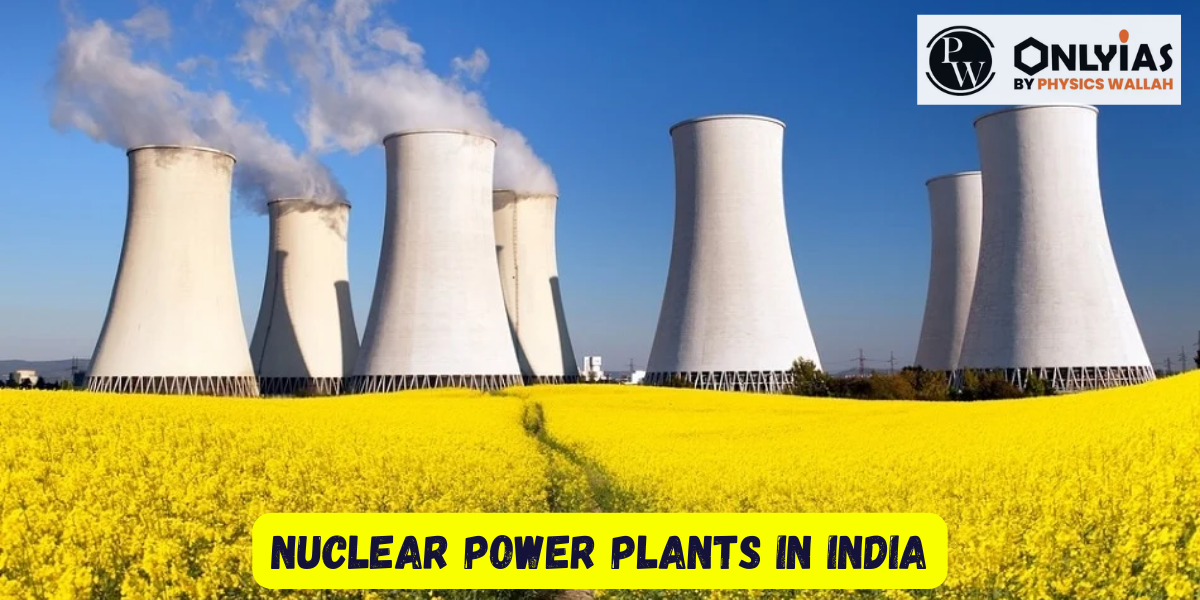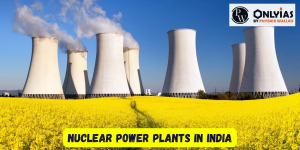Nuclear Power Plants are in India list is available here. Explore the complete details and list of operational Nuclear Power Plants are in India.

Nuclear Power Plants in India: India, with its ever-growing population and increasing energy demands, has been actively exploring alternative sources of power generation to supplement its conventional energy sources. Among these alternatives, nuclear power has emerged as a viable and significant component of the energy mix. Presently, India has spread across 24 nuclear power reactors. power plants play a crucial role in meeting the country’s growing electricity needs while striving to reduce carbon emissions and combat climate change. In this article, we delve into the current state of nuclear power plants in India, their significance, and the challenges they face.

India’s foray into nuclear energy dates back to the mid-20th century. In 1969, the country’s first nuclear power plant, Tarapur Atomic Power Station (TAPS), went operational in Maharashtra. It was built with technical assistance from the United States and marked the beginning of India’s journey into nuclear power generation. Since then, India has made significant strides in developing its nuclear infrastructure, both for civilian and military purposes.
The civilian nuclear program in India is governed by the Department of Atomic Energy (DAE), which operates under the Prime Minister’s Office. The primary objective of this program is to harness nuclear energy for peaceful purposes, including electricity generation, desalination, and research.
India had 24 operational nuclear reactors spread across seven nuclear power plants. These plants have a combined installed capacity of around 8,080 MW. Operational nuclear power plants in India represent a remarkable feat in the country’s pursuit of energy security and sustainable development. As one of the world’s fastest-growing economies, India faces the challenge of balancing economic growth with environmental concerns, making nuclear power an essential component of its energy mix. So, if you are wondering how many Nuclear Power Plants are in India, Below is a table detailing the operational nuclear power plants in India, including the unit, plant name, reactor type, capacity, and date of commercial operation:
| Unit | Plant Name | Reactor Type | Capacity (MWe) | Date of Commercial Operation |
|---|---|---|---|---|
| 01 | Tarapur Atomic Power Station (TAPS), Maharashtra | BWR | 160 | October 28, 1969 |
| 02 | Tarapur Atomic Power Station (TAPS), Maharashtra | BWR | 160 | October 28, 1969 |
| 03 | Tarapur Atomic Power Station (TAPS), Maharashtra | PHWR | 540 | August 18, 2006 |
| 04 | Tarapur Atomic Power Station (TAPS), Maharashtra | PHWR | 540 | September 12, 2005 |
| 05 | Rajasthan Atomic Power Station (RAPS), Rajasthan | PHWR | 0 | December 16, 1973 |
| 06 | Rajasthan Atomic Power Station (RAPS), Rajasthan | PHWR | 200 | April 1, 1981 |
| 07 | Rajasthan Atomic Power Station (RAPS), Rajasthan | PHWR | 220 | June 1, 2000 |
| 08 | Rajasthan Atomic Power Station (RAPS), Rajasthan | PHWR | 220 | December 23, 2000 |
| 09 | Rajasthan Atomic Power Station (RAPS), Rajasthan | PHWR | 220 | February 4, 2010 |
| 10 | Rajasthan Atomic Power Station (RAPS), Rajasthan | PHWR | 220 | March 31, 2010 |
| 11 | Madras Atomic Power Station (MAPS), Tamil Nadu | PHWR | 220 | January 27, 1984 |
| 12 | Madras Atomic Power Station (MAPS), Tamil Nadu | PHWR | 220 | March 21, 1986 |
| 13 | Kaiga Generating Station (KGS), Karnataka | PHWR | 220 | November 16, 2000 |
| 14 | Kaiga Generating Station (KGS), Karnataka | PHWR | 220 | March 16, 2000 |
| 15 | Kaiga Generating Station (KGS), Karnataka | PHWR | 220 | May 6, 2007 |
| 16 | Kaiga Generating Station (KGS), Karnataka | PHWR | 220 | January 20, 2011 |
| 17 | Kudankulam Nuclear Power Station (KKNPS), Tamil Nadu | VVER-1000 (PWR) | 1000 | December 31, 2014 |
| 18 | Kudankulam Nuclear Power Station (KKNPS), Tamil Nadu | VVER-1000 (PWR) | 1000 | March 31, 2017 |
| 19 | Narora Atomic Power Station (NAPS), Uttar Pradesh | PHWR | 220 | January 1, 1991 |
| 20 | Narora Atomic Power Station (NAPS), Uttar Pradesh | PHWR | 220 | July 1, 1992 |
| 21 | Kakrapar Atomic Power Station (KAPS), Gujarat | PHWR | 220 | May 6, 1993 |
| 22 | Kakrapar Atomic Power Station (KAPS), Gujarat | PHWR | 220 | September 1, 1995 |
| 23 | Kakrapar Atomic Power Station (KAPS), Gujarat | PHWR | 700 | June 30, 2023 |
| 24 | Kakrapar Atomic Power Station (KAPS), Gujarat | PHWR | 700 | March 31, 2024 |
Total Nuclear Power Plant Capacity: 8080 MWe
Located in Tamil Nadu, the Kudankulam Nuclear Power Plant is a joint venture between India and Russia. It consists of two VVER-1000 pressurized water reactors, each with a capacity of 1,000 MW. Kudankulam has been an important milestone in the India-Russia nuclear collaboration and played a vital role in enhancing India’s nuclear energy capacity.
RAPS, situated in Rawatbhata, Rajasthan, is India’s first nuclear power plant. It currently houses six pressurized heavy water reactors (PHWRs) with a combined capacity of around 1,180 MW. RAPS has been instrumental in demonstrating India’s indigenously developed nuclear technology.
Kaiga, located in Karnataka, is another notable nuclear power plant in India. It operates four indigenously developed 220 MW pressurized heavy water reactors, producing a total of approximately 880 MW. Kaiga has been consistently providing reliable and clean energy to the southern region of India.
India’s nuclear power generation capacity is expected to increase in the coming years, as several new projects are in the pipeline. The government has set ambitious targets to expand the nuclear energy sector to reduce its dependence on fossil fuels and address the challenges posed by climate change.
India plans to construct additional reactors at existing nuclear power plants to optimize resources and streamline operational processes. These projects are aimed at enhancing the capacity of existing plants and ensuring a steady supply of electricity.
Apart from expanding existing plants, India is actively working on establishing new greenfield projects. Notable among these are the Gorakhpur Haryana Anu Vidyut Pariyojana (GHAVP) and the Chutka Nuclear Power Plant in Madhya Pradesh.
Despite the significant strides made by India in nuclear energy, the sector faces several challenges and concerns:
Safety concerns surrounding nuclear power persist in India, particularly after the Fukushima nuclear disaster in Japan in 2011. Addressing safety issues and gaining public confidence remain critical for the expansion of the nuclear energy sector.
Nuclear power plants require substantial initial investments, and financing these projects can be a significant challenge. Securing cost-effective financing and ensuring long-term profitability are essential for the sustainability of nuclear power projects.
The proper management of radioactive waste is a major concern. India must adopt robust waste management strategies to prevent environmental contamination and safeguard public health.
Nuclear power plants in India have played a crucial role in meeting the country’s growing electricity demands while aiming to reduce carbon emissions and combat climate change. With ambitious expansion plans and continued technological advancements, nuclear energy is expected to remain a key component of India’s energy mix in the foreseeable future. However, addressing safety concerns, implementing effective waste management strategies, and ensuring cost-effective financing will be essential to unlock the full potential of nuclear power in India.
Nuclear energy ranks as the fifth-largest electricity source in India, trailing behind thermal, hydroelectric, and renewable sources. Currently, the country operates 22 nuclear power reactors across seven states, collectively providing an installed capacity of 6780 MegaWatt electric (MWe). Among these reactors, 18 are Pressurised Heavy Water Reactors (PHWRs), while the remaining four are Light Water Reactors (LWRs).
Responsible for generating nuclear power, the Nuclear Power Corporation of India Limited (NPCIL), headquartered in Mumbai, operates as a government-owned corporation under the administration of the Department of Atomic Energy, Government of India.
Presently, India operates 24 functional nuclear reactors collectively generating an installed capacity of 8080 MWe.
The seven nuclear power stations in India are located in the following states: Tarapur Atomic Power Station (TAPS) - Maharashtra Rajasthan Atomic Power Station (RAPS) - Rajasthan Madras Atomic Power Station (MAPS) - Tamil Nadu Kaiga Atomic Power Station (KAPS) - Karnataka Kakrapar Atomic Power Station (KAPS) - Gujarat Kudankulam Nuclear Power Plant - Tamil Nadu Narora Atomic Power Station (NAPS) - Uttar Pradesh
Prime Minister Jawahar Lal Nehru inaugurated Apsara, the first nuclear reactor in India and Asia, on January 20, 1957.
Kudankulam Nuclear Power Plant (KKNPP), located in Kudankulam, Tamil Nadu, in the southern part of India's Tirunelveli district, holds the distinction of being India's most extensive nuclear power station.

<div class="new-fform">
</div>